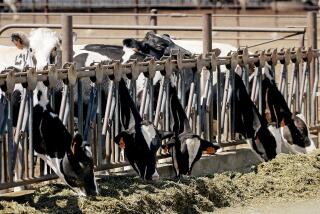Farmers Facing Ever-Changing Row to Hoe
- Share via
CASTILE, N.Y. — Calvin DeGolyer savors memories of his boyhood on the family farm, back when horses pulled every plow, cows were milked by hand and caring for 200 chickens was his 4-H Club project.
Farmers like his father raised a variety of livestock and crops, and sold surplus meat and cream in the village. Neighbors relied on neighbors and the Fourth of July celebration started with a community prayer.
Then Calvin and his two brothers went off to fight in World War II, the eldest never to return. When he came home in 1946, the first signs of the monumental change in agriculture over the next 50 years awaited them.
“Dad had a little tractor and a milking machine,” DeGolyer, 74, recalls. “We kinda hooked our tail to a wildcat. Mechanization was what really changed things. We had to learn to adapt to it and go with it and not let it get the best of us.”
The drift toward bigger, fewer and more specialized farms, driven by rapid advances in science and technology, carried the DeGolyers with it. At crucial points along the way, three generations of the family tried to steer an innovative route at Table Rock Farm. Sometimes that meant latching onto new ideas--planting corn in narrower rows, injecting manure in the soil, more judicious use of pesticides--that strike a balance between conservation and commerce and invoke the common-sense practices of a long-ago era.
It was 1915 when C. Scott DeGolyer, an engineer for the U.S. Geological Survey, fell in love with the 600-foot-deep gorge near this western New York village and bought a tract of gently rolling upland nearby.
The old 115-acre spread--with an apple orchard, wheat, alfalfa and bean fields, 30 ewes, 10 cows, four horses and a flock of chickens--is now a 1,020-acre, high-tech dairy with 900 Holsteins, a dazzling array of harvesters and milking gear and more than $2 million in annual sales.
“In my grandfather’s time, the concept was, ‘Don’t put your eggs in one basket!’ ” says Calvin’s nephew, Willard. “Now, you put your eggs in one basket, but you make sure it’s a pretty good basket.”
Even here in the forward-leaning, big-farm country of Wyoming County, Table Rock Farm stands as a model of efficiency. Each cow delivered 24,000 pounds of milk and each acre produced 22 tons of corn silage last year, both one-third more than the statewide average.
Hybrid crops, fertilizers and pesticides have sent yields way up, just as artificial insemination, computer-calculated diets and airy, stall-free barns designed to minimize stress have transformed animals into superperformers.
In New York, half as many cows (703,000) are producing twice as much milk (11.6 billion pounds) as a century ago.
More to Read
Sign up for Essential California
The most important California stories and recommendations in your inbox every morning.
You may occasionally receive promotional content from the Los Angeles Times.













